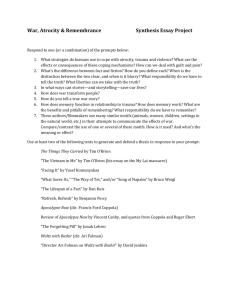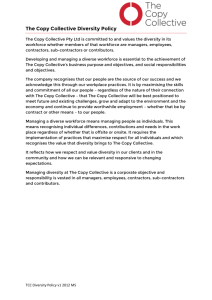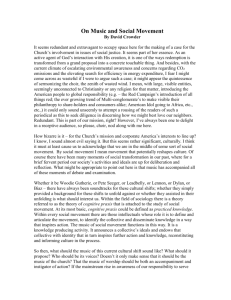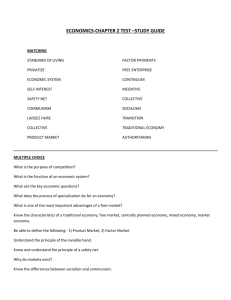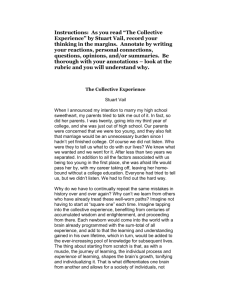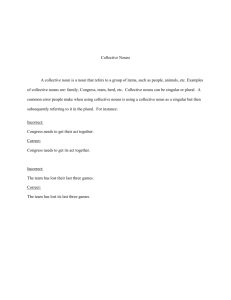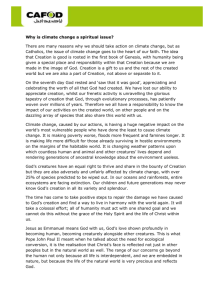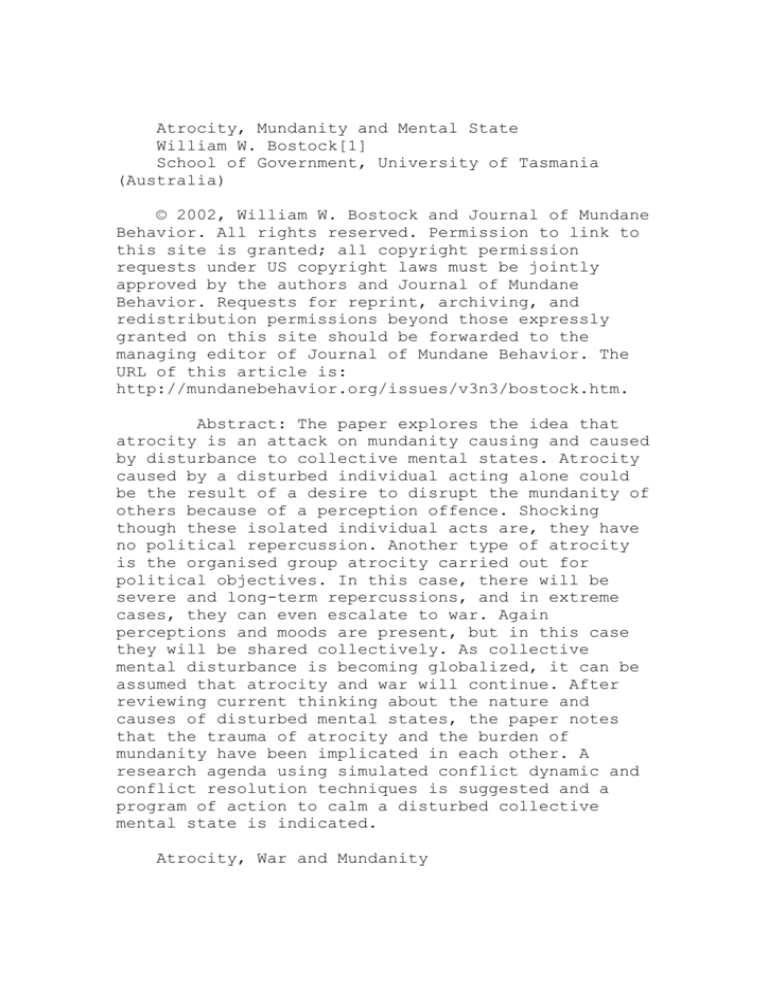
Atrocity, Mundanity and Mental State
William W. Bostock[1]
School of Government, University of Tasmania
(Australia)
© 2002, William W. Bostock and Journal of Mundane
Behavior. All rights reserved. Permission to link to
this site is granted; all copyright permission
requests under US copyright laws must be jointly
approved by the authors and Journal of Mundane
Behavior. Requests for reprint, archiving, and
redistribution permissions beyond those expressly
granted on this site should be forwarded to the
managing editor of Journal of Mundane Behavior. The
URL of this article is:
http://mundanebehavior.org/issues/v3n3/bostock.htm.
Abstract: The paper explores the idea that
atrocity is an attack on mundanity causing and caused
by disturbance to collective mental states. Atrocity
caused by a disturbed individual acting alone could
be the result of a desire to disrupt the mundanity of
others because of a perception offence. Shocking
though these isolated individual acts are, they have
no political repercussion. Another type of atrocity
is the organised group atrocity carried out for
political objectives. In this case, there will be
severe and long-term repercussions, and in extreme
cases, they can even escalate to war. Again
perceptions and moods are present, but in this case
they will be shared collectively. As collective
mental disturbance is becoming globalized, it can be
assumed that atrocity and war will continue. After
reviewing current thinking about the nature and
causes of disturbed mental states, the paper notes
that the trauma of atrocity and the burden of
mundanity have been implicated in each other. A
research agenda using simulated conflict dynamic and
conflict resolution techniques is suggested and a
program of action to calm a disturbed collective
mental state is indicated.
Atrocity, War and Mundanity
...a group of individuals, most of whom are
perfectly inoffensive, may, when gathered in a crowd,
be drawn into acts of atrocity.
(Durkheim, 1964 [1895]: 5).
This paper will take this observation as its
starting point.
Atrocity is an attack on mundanity. Atrocity is
an act of heinous wickedness or wanton cruelty that
can occur at any time or place, and when it is
perpetrated by a disturbed individual acting alone,
could be the result of a desire to disrupt the
mundanity of others because of that individual's
perception and mood. Shocking though these isolated
individual acts are, they have no political
repercussion. When the atrocity is perpetrated by an
organised group it has severe repercussions of
retaliatory atrocity, preventative atrocity (such as
genocide) or, in extreme circumstances, war. It is
important, therefore, to try to understand the
motivations to commit atrocity: whether provoked or
unprovoked--as when, for example, it is for allegedly
therapeutic reasons.
War is a legitimised atrocity, although
particularly gross acts of wanton destruction of noncombatants (including surrendered troops) are
regarded as war crimes. The firebombing or nuclear
bombing of cities has been controversial, regarded by
some but not others as an atrocity. As war is
legitimised atrocity, the labelling of an act of
atrocity as an act of war will have huge implication
as to the legitimisation of the atrocity. For this
reason, most atrocity perpetrators will be at pains
to have their acts accepted as legitimate acts of
war.
Mundanity pertains to the worldly, earthly
preoccupations with everyday life, and while in
itself it is generally a benign set of activities and
rituals, that is, the daily routine of "the
'unmarked'--those aspects of our everyday lives that
typically go unnoticed by us," as the Journal of
Mundane Behavior describes it (JMB, 2002), or the
'texture of daily lived reality' (Orleans, 2001: 2).
But the mundanity of one individual, group,
community, or civilization may be an affront to
certain other individuals and groups. Mundanity, when
seen through the distorting lens of a disturbed
mental state, could be seen as demanding and
justifying nothing less than an act of atrocity,
though the act probably won't be seen and interpreted
by its perpetrator as an atrocity but rather an act
of war, legitimized atrocity, or even of therapeutic
value. Atrocity and war causing severe disruption to
mundanity have long been regarded as having major
implications for mental health, but it can also be
argued that they are also a product of disturbed
mental states at a collective level.
From a methodological point of view it would be
desirable to interview in depth atrocity perpetrators
both before and wherever possible after the act of
atrocity, so as to test this hypothesis. However,
given the nature of the subject, the enquirer must
rely on media interviews, memoirs, and the reports of
perpetrators' associates. There is also an
alternative approach through the powerful insight of
literature: specifically the desire to spread
unhappiness to others, so as to make them pay for
one's own unhappiness, as found in the works of
Shakespeare, Dostoevsky, and Zola, to name just
several sources of this particular insight.
Therefore, one can generate intuitively a hypothesis-the cause of atrocity is a disturbed collective
mental state--and place this before the reader in the
hope of response.
Collective Mental States: Do They Exist?
In Australia there is currently a Minister of
Immigration who, when told that illegal immigrants
were found by a UN Working Party to be suffering
collective depression, replied that he did not know
what the term meant (Age, June 7, 2002). Many
academics also deny that collective mental states
exist, as do some members of the public. This could
be because collective consciousness seems to imply a
group mind, or the idea of a hypothetical collective
transcendent consciousness or spirit which was
assumed to characterise a group or community (Reber,
1995: 323). The methodological problem of how such an
entity could be tested empirically has had the effect
of placing it outside modern empirical social
science, which is predominantly quantitative, leading
one observer to comment that 'there has been
practically no research directly assessing the
reality of collective consciousness' (Varvoglis,
1997:1).
This notwithstanding, a survey of current social
science literature finds a surprisingly large amount
of reference to various conditions of collective
mental state, such as collective dignity (Smith,
1991: 163), collective fear (Lake and Rothchild,
1996), collective vulnerability (Orleans, 2001),
collective memory (Takei, 1998), and collective
consciousness (Munayyer, 1999). The health
disciplines reveal a longer but also intermittent
interest: collective anxiety neurosis was
hypothesised by the psychiatrist Kiev (1973),
collective habituation to genocide was discussed by
the psychoanalyst Shatan (1976: 122), collective
retribution by the psychologist Staub (1992: 164) and
collective trauma from the perspective of health care
by Myers (1999). Collective responsibility (Harff,
1995), collective moral responsibility (Pies, 20001)
and collective guilt (Johnstone, 1999) have also been
discussed as a problems of moral philosophy while
from the perspective of sociolinguistics collective
language grief has been discussed in relation to
communities that have lost or anticipate the loss of
their language (Bostock, 1997). Language itself is a
collective right (Kymlicka, 1995) or droit collectif
(Breton, 1997: 47).). Psychohistory is another
important approach to collective mental states, in
particular the importance of trauma during childhood
(Scharf, 2000). Organisational theorists have
considered collective organisational anxiety as an
important factor in their subject of interest which
is a collective mental model (Voyer, Gould and Ford,
1996). All of these conditions can be grouped under
the general category of collective mental state, but
it is possible that there is a particular mixture of
conditions that can become a dangerous impulse to
atrocity: for example, collective depression over
unwanted mundanity, combined with desire for
collective retribution.
The Motivations to Commit Atrocity
(1) The Depression of Unwanted Mundanity
Psychological factors are recognised as being
very important as causes of depression, and
depression can be a precondition for atrocity. For
example, depression is often actuated by the illness
or death of someone close or other forms of profound
loss including loss of hope for the future or other
form of grief (Haig, 1990: 7-11). Individual
depression is thus characterised by a loss of
personal hopefulness which is now becoming recognised
as an important part of the mind-body relationship
(Nunn, 1996), and this applies equally to group
depression.
Another variant of this view is that depression
is caused by feelings of learned helplessness, which
results when punishment is received without being
contingent upon the actions of the individual
(Collier, Longmore and Harvey, 1991: 336). Learned
helplessness could be considered as similar to a loss
of control over one's life, even in, or particularly
in, its mundanity.
The World Health Organization has recognised the
spread and significance of depression, noting that
mood disorders (including depression) are estimated
to affect some 340 million people, that is, of
epidemic proportion. In the United States of America
alone, the yearly cost of depression is estimated at
US$44 billion, equal to the total cost of all
cardiovascular diseases. (WHO, 1997).
José Maria Vigil has investigated the
psychological well-being of the Latin American
continent and diagnosed a state of collective
depression, that is, as having actually the same
symptomatology as for individual depression:
disappointment, loss of self esteem, self accusation,
demobilisation, disorientation, depoliticization,
escape into spiritualism, loss of memory, withdrawal
and psychosomatic problems (Vigil, 2000: 2). It is
possible in a similar way, to assess the condition of
a large proportion of young people as being one of
collective depression.
A mundane condition of starvation, famine, civil
war and political oppression, would not always cause
atrocity, but one could conceive these as
preconditions for atrocity. The burden of unwanted
mundanity is not confined to the Third World. Many
people, particularly young adults, in affluent
developed societies such as those of North America,
Europe or Australasia, are showing symptoms of
depression.
The epidemic of depression now becoming
globalized could be a response to the tension in
global culture: on the positive side of this
particular stage of cultural development is the
promise of infinite lifestyle possibilities, choice,
freedom and consumer goods, while on the negative
side, which is more likely to correspond to reality,
is poverty, disease, deprivation and the loss of
hope, with a particular group being seen as
responsible for this situation--a mind-set to which
many young people, especially those in third world
countries, may be particularly susceptible.
As Eckersley puts it,
...(t)he situation may also reflect a growing
failure of modern Western culture to provide an
adequate framework of hope, moral values, and a sense
of belonging and meaning in our lives, so weakening
social cohesion and personal resilience.... In
investing so much meaning in the individual "self,"
we have left it dangerously exposed and isolated,
because we have weakened the enduring personal,
social and spiritual relationships that give deeper
meaning and purpose to our lives. (Eckersley, 1997).
The burden of the deep inner void created by an
unfavourably or degradingly mundane society is a
dangerously unstable situation because this void can
be filled by bad or evil leaders who can instigate
atrocity, the classic example being Hitler, who in
Mein Kampf promised that "heads would roll." In the
context of modern organization theory, Hirschhorn has
confirmed the conclusion that certain types of
leadership can have "toxic effects" on organizational
motivation (Hirschhorn, 1990: 533), and this insight
can surely be applied to societies at the political
level.
(2) Revenge
A depressed mental state could not in itself be
seen as a cause of atrocity, but it may create the
kind of mental disturbance created by events or
deliberate manipulation that can end with atrocity.
Specific atrocity can cause depression not only in
those individuals immediately affected by loss, but
also at a collective level. Atrocity can therefore
create the condition for further atrocity.
Collective memory of a past atrocity can be a
motivation to atrocity. In 1389 in the Battle of
Kosovo, Turkish invaders committed atrocities as part
of their conquest of the Balkans, and avenging these
have been put forward as grounds for attack on
Islamic Kosovars in 1998.
Writing earlier on the wider subject of the
disintegration of the former Yugoslavia, the novelist
Danilo Kis identified nationalism as the causal
factor: a state of collective and individual
paranoia, where collective paranoia is a combination
of many individual paranoias brought to paroxysm in a
group whose goal is '...to solve problems of
monumental importance: survival and prestige of that
group's nation.' (Kis, 1996: 1). Atrocity was thus
interpreted as nationalism, not atrocity.
Psychologists and others have long been concerned
with explaining aggression or unprovoked attacks or
acts of hostility, and many theories have been put
forward. Firstly there is the instinct theory of
aggression, represented among many others by Freud
who recognised a destructively powerful death
instinct, and also by Lorenz (1966) in whose view
aggression was a survival-enhancing instinct which is
present in human beings as well as other animals, and
which can be collective as well as individual. A
second view is that aggression is a learned response,
rationally chosen and dispassionately employed in the
furtherance of selected goals by children,
adolescents, adults, and groups such as politicians
and the military (Gurr, 1970, 32). The third approach
is the 'frustration-aggression theory' first proposed
by Dollard (1939). Here aggression is seen as a
response to frustration caused by interference in the
pursuit of goals or any other disturbance to the
collective mental state. The aggressive response to
frustration is seen as a biologically inherent
tendency in humans and other animals, and is not
necessarily incompatible with the other two
approaches. None of the three approaches is
exclusive, but of the three approaches, the latter
seems to be the most widely accepted. For example,
Gurr takes the view that '...the primary source of
human capacity for violence appears to be the
frustration-aggression mechanism...' (1970, 36), but
he goes on to include among the sources of
frustration the sense of relative deprivation, which
can be infinitely diverse in origin, nature and
response.
The desire for revenge can affect certain strata
of society, specific groups, communities, nations and
even continents, and can be so widespread and
generalised that the term collective vengeance can be
used to describe the situation. A specific event such
as the unexpected death of a public figure such as a
political leader by assassination can be the cause of
an episode of collective vengeance and ultimately be
a trigger for war or genocide, as was the
assassination by aircraft destruction of President
Juvenal Habyarimana of Rwanda in 1994.
(3) Reactive or Preventative Atrocity
As already noted, war is legitimized atrocity.
While often retributive, atrocity can also be preemptive or preventative. War can be open armed
conflict, as between sovereign states, but war can
also occur within states as civil war, wars of
secession (possibly having an identity component) or
wars of independence between pro-independence forces
and a colonial or other type of occupying state. Here
the labelling process as atrocity, act of terrorism
or legitimate act of war, is critical, as external
support will depend on whichever label is accepted.
Civil war is war within a state where the
objective is control of a state, and thus differs
from secession of a part from the whole with a view
to gaining the power to implement a particular form
of government, policy or regime. In civil war both
sides are likely to be highly organised and heavily
armed, as in the American Civil War (1861-1865),
where loss of life was higher than for Americans in
World War 2, or the Spanish Civil War (1936-1939)
where the bloodshed was also very great. Both civil
wars were about ideology: the former in relation to
the issues of race and central government, and the
latter was concerned with class, religion, and land
ownership but with an ethnic implication in that
Catalonia and the Basque Country, with their distinct
ethnic identities, were strongholds of Republican
support with some sympathy in Galicia. In some civil
wars, ethnicity has played no part: in the English
Civil War (1642-1648), ideology and regime change
seem to have been the main issues. When civil war has
an identity dimension, it can generally be assumed
that many grievances will be implicated, either
overtly, as in the situation involving the Kurds or
the civil war in Sri Lanka (Bostock 1997) or as in
the civil war between the IRA and the British
Government in Northern Ireland, where the past and
present treatment of Irish Gaels is an important item
in the store of grievances embedded in collective
memory. All of these civil wars have been heavily
marked by atrocity.
(4) Collective Fear
Creating collective fear among a targeted
population seems to be a common aim among the
perpetrators of atrocity. As Orleans states "This is
the prime objective of terrorism: to alter the
texture of daily lived reality by injecting a blend
of apprehension, trepidation, despair and ruin."
(Orleans, 2001: 2). Hitler created and used the
mental state of fear of atrocity by the advancing
Russians as a means to control the German public and
prolong World War 2 in Europe. The orchestration of
individuals, families and communities into agents of
homicidal/suicidal behaviour through the manipulation
by fear is a frequently observed and generalised
component of the same dynamic in which atrocity is
perceived both as an immanent threat and a potential
resolution.
The generalized state of fear does provide
another precondition for atrocity.
When a large number of people collectively
experience fear, one can say that this fear is a
product of the collective mental state. Such a state
can be engineered by the controlled supply of
information and interpretation, which is used to
generate collective anxiety. Lake and Rothchild
expanded on this theme when they wrote that
As groups begin to fear for their safety,
dangerous and difficult-to-resolve strategic dilemmas
arise that contain within them the potential for
tremendous violence....Ethnic activists and political
entrepreneurs, operating within groups, build upon
these fears of insecurity and polarise society. (Lake
and Rothchild, 1996: 41).
Most studies of organised violence do not
attribute all causality to leadership, as there must
be a facilitating followship or at least acquiescent
bystanders (Staub, 1989: 23), and very likely a
situation where the "raw material" of collective
grievances are present.
(5) Collective Desensitization to Violence
Suicide and violence towards others including
homicide are closely related. WHO reports that
violence in all its forms has increased dramatically
worldwide in recent decades. During 1993, at least 4
million deaths resulted from unintentional or
intentional injury, including 300,000 murders. Of the
violent deaths, some 3 million were in the developing
world. In many countries, homicide and suicide
account for 20%-40% of deaths in males aged 15-34 and
in half the countries of Latin America and the
Caribbean, homicide is the second leading cause of
death in people aged 15-24. It is more frequent among
men, increases in direct relationship with age, and
is closely associated with depression, personality
disorders, substance abuse and schizophrenia (WHO,
1997). It should be noted, however, that sufferers of
specific mental illnesses generally have no greater
proclivity towards violent crime than other members
of a population (Siegfried and Goetinck, 1996). It
would seem inevitable that a climate of generalized
violence would favour the planning and execution of
atrocity.
Borkenau took up this point when he related the
mental state of proclivity towards violence to the
effect of severe changes to the social and political
milieux in which violence becomes commonplace:
Once the carapace of custom is disrupted, the
process acquires the characteristics of a chain
reaction. Every rift opened by the devaluation of
rules widens automatically and produces new rifts in
other places....conduct becomes more and more
irrational, the area of moral uncertainty is
constantly widening, until the typical situation of
the "dark ages," a situation of total insecurity and
universal crime, is reached. (Borkenau, 1981: 385).
(6) Therapeutic Atrocity
Sometimes killing is seen as healing, as in
suicide, but killing others can also be seen as an
act of healing, as in supposedly benevolently
motivated collective euthanasia. An example of this
is the war of extermination, where a power seeks to
completely extirpate a whole category of people by
genocide (Kuper, 1981), for the believed therapeutic
benefit of the perpetrators and sometimes even for
the victims, as in a kind of mercy killing. The war
of extermination may be limited in scope, or
disguised as resettlement, as in the Black War in
Tasmania (Kuper, 1981, 40), or it may be wholesale as
in the Third Reich where a considerable number of
categories of people were targeted (Hilberg, 1967) or
Cambodia under Pol Pot which has been described as an
autogenocide in that Cambodians themselves were
targeted (Staub, 1989).
In the light of this discussion, it is possible
to hypothesise that the impulses towards aggressive
behaviours provide a complex assortment of
motivations to atrocity, culminating in homicidal,
genocidal and suicidal acts (these often being
related) and a diverse range of other atrocities
including mass rape and mass mutilation. However
there is always present a common factor: a disturbed
collective mental state.
Philosophical Implications of a Disturbed
Collective Mental State
Thus the condition of the collective mental state
can be hypothesised as having an essential role in
the great question of human society: order or
conflict, peace or war, accommodation or genocide,
mundanity or atrocity.
The precise nature of the link between mental
state and behaviour is the age-old philosophical and
moral question of responsibility, which will remain
unresolved. Another way of looking at the same
problem is to say that antisocial behaviour may not
be a result of illness: "... harm to society...should
not be part of the definition of mental illness,
because to include it would open the door to saying
that, for example, all rapists and all those who
oppose society's aims are mentally ill" (Collier,
Longmore and Harvey, 1991: 314). However, it is
obvious that the necessary task of co-ordinating
large-scale violence requires large numbers of
willing participants and therefore that similarity of
motivation, mood, ontology, information supply and
interpretation must be assumed. However, such
violence also requires that a moral choice that has
been made and, therefore, cannot be excused. As Pies
has written: "Terrorism, in short, is a moral choice-and in principle, it is reversible." (Pies, 2001:
4).
Pies (2001:1) discussed the problem of whether
there can be a collective psychopathology when he
wrote "only a clinical evaluation can determine
whether an individual suffers from a mental illness,
and no group can be diagnosed en masse." He then went
on to state that "we justifiably may ask: is
terrorism related to certain habitual ways of
thinking that have analogies in some psychiatric
disorders? I believe so." Pies thus gives a valuable
confirmation to the hypothesis of this article, but
his position also creates a problem: if one uses
clinical terms for which there might be specific
diagnostic tests, then one is making a collective
diagnosis which can then only be metaphorical.
An answer to this problem is to avoid the use of
clinical terminology such as disorder, paranoia,
(noting that depression is both a clinical term and a
plain English term), though one can well accept the
right of others to use those terms. But it is still
possible to describe in plain English the collective
mental state of a community both relative to other
communities and also in terms of changes to its
former self. These conditions could be summarised as
having a collective mental state that is either
adjusted to its circumstances or disturbed. But how
does an adjusted or disturbed mental state in an
individual becomes collectivised?
The Functioning of Collective Mental States
Many social scientists have suggested that the
mechanism by which collective consciousness comes
about is contagious reciprocity. Kiev developed this
theme when he saw not only depression but collective
anxiety neurosis as being spread by contagion,
analogous to an infectious disease (Kiev, 1973: 418).
Another mechanism of change in collective mental
state is the result of collective trauma, which works
by changing the existing ties between survivors
(Myers, 1999: 2). Among individuals, it has been
recognised that stress can be a cause of or trigger
for disorder, so that when stress is widespread
throughout a community, a significant change in the
collective mental state can be predicted. At the
collective level, it has often been observed that
major traumatic events or continuing conditions of
extreme stress (such as in ghettos) do produce a
heightened incidence of suicide and other indicators
of mental illness, though in actual war, suicide
rates do drop.
An important mechanism is the feedback loop. In
their study of an industrial plant, Voyer, Gould and
Ford (1999) found that many efforts to reduce
organisational anxiety were counterproductive because
of the presence of reinforcing feedback loops between
the various elements of collectively held attitudes
and perceptions. There were also balancing feedback
loops which had the effect of reducing anxiety and
helping the organization to achieve equilibrium, that
is, its position before a stressful event. The
collective mental state of anxiety is therefore
increased or decreased through the mechanism of
feedback. Voyer, Gould and Ford referred to a Dutch
study which showed that in one organization, the
leader's role was in fact the only balancing feedback
loop (Voyer, Gould and Ford, 1999: 3), an early
confirmation of the idea that leaders or rulers have
an important part to play in the dynamics of the
collective mental state.
The common element in the various mechanisms of
change in the collective mental state--contagion,
shared trauma or feedback loop--is communication of
memory and perception and interpretation of reality:
whether these perceptions are well founded in reality
is immaterial.
Conclusion: Calming the Collective Mental State
Atrocity is an attack on mundanity causing and
caused by disturbance to a collective mental state.
Sometimes a particular mundanity can be interpreted
as offensive and calling for atrocity. This process
can create the conditions for conceiving further
atrocity in a process of endless recycling. Atrocity
can escalate to war or legitimized atrocity (which
rarely settles a conflict) or genocide (which is the
fullest expression of preventative or therapeutic
atrocity).
What is needed is the application of atrocity
avoidance techniques, and here many experiments have
been carried out in simulated conflict and conflictresolution exercises, often as part of academic
courses. Constructive compensation for past atrocity,
the removing of the depression caused by both
atrocity and mundanity, and major modification of the
collective mental state by creating the calming
influence of an atmosphere of hopefulness, often
while working in conditions of extreme difficulty and
discouragement, is the essential task. For reasons of
responsibility and therefore atrocity cycle
reduction, atrocities must not go unpunished. But the
punishment should not be violent, as in capital
punishment or state-sponsored assassination, which
exacerbates rather than calms the mental state of the
associated group through contagion with trauma
amplified by feedback loops. Here one could refer to
the execution by the British of the leaders of the
Irish Uprising of 1916 (with the exception of de
Valera who held United States citizenship), and for
which, it could be argued, Britain is still paying a
price today.
When mundanity is degrading it should be
recognised as a potential cause of atrocity, and
practical steps at alleviation must be undertaken.
One line of investigation has suggested enquiry into
the causal power of the group to change individuals
when they become part of a group. In this view,
leadership is important among the group processes
that require research (Forsyth 1996: 5). Leadership
can instil a sense of future, and here it could be
relevant to be reminded of the phrase attributed to
Dag Hammarskjöld: "the future: yes."
Note
[1] The author would like to thank some anonymous
reviewers for their valuable comments on an earlier
version of this paper.
Works Cited
Age, The (Melbourne Newspaper), (2002). Federal
Politics, June 7.
Borkenau, Franz, (1981). End and Beginning, On
the Generations of Cultures and the Origins of the
West, (ed. and intro. by Richard Lowenthal). New
York: Columbia University Press.
Bostock, W.W., (1997): "Language Grief: A 'Raw
Material' of Ethnic Conflict." Nationalism & Ethnic
Politics 3, no. 4: 94-112.
Breton, Roland, (1997). 'Le droit á la langue:
vers le droit des gens, par delá les droits de
l'homme'. In Synak, Brunon and Tomasz Wicherkiewicz,
(eds.), Language Minorities and Minority Languages in
the Changing Europe. Proceedings of the 6th
International Conference on Minority Languages,
Gdansk, 1-5 July, Gdansk: Wydawnictowo Uniwersytetu
Gdanskiego.
Collier, J.A.B, Longmore, J.M., and Harvey, J.H.,
(1991). Oxford Handbook of Clinical Specialities,
Third Edition. Oxford, New York, Tokyo: Oxford
University Press.
Dollard, John, (1939). Frustrations and
Aggressions. With Neal E. Miller, Leonard .W. Doob,
O.H. Mowrer and Robert R. Sears, in collaboration
with Clellan S. Ford, Carl Iver Hovland, Richard T.
Sollenberger. New Haven, Pub. for the Institute of
Human Relations by Yale University Press.
Durkheim, E., (1964). The Rules of Sociological
Method. New York: Free Press and London: CollierMacmillan.
Eckersley, R. (1997). 'Psychosocial disorders in
young people: on the agenda but not on the mend'.
EMJA. (E Medical Journal of Australia),
http://www.mja.com.au/public/issues/apr21/eckersley/e
cker.html (Sighted May 30, 2001).
Forsyth, D.R., (1996). 'Interfacing Social and
Clinical Approaches to Mental Health'. Virginia
Commonwealth University, Grand Rounds Presentation,
February 9.
http://www.vcu.edu/hasweb/pzy/faculty/fors/grand.html
(Sighted August 30, 2000).
Gurr, Ted Robert, (1970). Why Men Rebel.
Princeton, Princeton University Press.
Haig, R.A. (1990). The Anatomy of Grief,
Biopsychosocial and Therapeutic Perspectives.
Springfield: Charles Thomas.
Harff, Barbara, (1995). "Rescuing endangered
peoples: missed opportunities". Social Research,
62,1, (Spring): 23-41.
Hilberg, Raoul, (1967). The Destruction of the
European Jews. Chicago, Quadrangle.
Hirschhorn, L., (1990). "Leaders and Followers in
a Post-industrial Age: A Psychodynamic View": Journal
of Applied Behavioural Science, 26, 4, 529-542.
JMB, (2002). Journal of Mundane Behavior, Home
Page. http://mundanebehavior.org/index.htm (Sighted
July 17, 2002).
Johnstone, Diana, (1999). Collective Guilt and
Collective Innocence.
http://emperor.vwh.net/articles/Johnstone/GUILT.htm
(Sighted July 17, 2002).
Kiev, Ari, (1973). 'Psychiatric Disorders in
Minority Groups'. In Peter Watson, (ed.), Psychology
and Race. Chicago: Aldine, 416-431.
Kis, Danilo, (1996). 'On Nationalism'. Performing
Arts Journal, 53, 18.2 13-16.
http://muse.jhu.edu/demo/performing_arts_journal/18.2
kis.html. Sighted July 14, 1999.
Kuper, Leo, (1981). Genocide. Its Political Use
in the Twentieth Century. Harmondsworth, Penguin.
Kymlicka, Will, (1995). Multicultural
Citizenship, a Liberal Theory of Minority Rights.
Oxford: Clarendon Press.
Lake, David A & Rothchild, Donald (1996).
"Containing Fear: The Management of Transnational
Ethnic Conflict". International Security, 21(2): 4175.
Munayyer, Spiro, (1998). "The fall of Lydda".
Journal of Palestine Studies, 27, 4, 80-99.
Myers, Diane, (1999). Disaster Response and
Recovery: a Handbook for Mental Health Professionals.
Menlo Park, AA: National Centre for Post-Traumatic
stress Disorder.
http://www.empowermentzone.com/disaster.txt. (Sighted
28 June 1999).
Nunn, K.P., (1996). "Personal hopefulness: A
conceptual review of the relevance of the perceived
future to psychiatry", British Journal of Medical
Psychology, 69, 227-245.
Orleans, Myron, (2001). "'Post-Terror' People:
Reclaiming Mundane Life", Journal of Mundane
Behavior, 2.3, (October),
http://mundanebehavior.org/issues/v2n3/orleans2-3.htm
(Sighted August 2, 2002).
Pies, Ronald, (2001). "A Simple Way to End
Terrorism." Journal of Mundane Behavior, 2.3,
(October), http://mundanebehavior.org/index.htm
(Sighted August 2, 2002).
Reber, Arthur S., (1995). The Penguin Dictionary
of Psychology, Second Edition. London, New York,
Ringwood, Toronto, Auckland: Penguin.
Scharf, Robert A., (2000). 'Why War? And other
Burning Questions: An Invitation to Psychohistory',
Forum: Qualitative Social Research, 1, 1, (January)
http://qualitative-research.net/fqs-texte/1-00/100scharf-e.htm (Sighted May 30, 2001).
Siegfried, T. and Goetinck, S., 1996).
"Association Between Violence, Mental Illness
Disputed.' Dallas Morning News.
http://www.pendulum.org/articles/dmn_violence.htm
(Sighted March 3, 2001).
Shatan, Chaim F., (1976). "Genocide and
Bereavement". In Richard Arens, ed. with epilog by
Elie Wiesel, Genocide in Paraguay. Philadelphia:
Temple University Press, pp. 102-131.
Smith, Anthony D., (1991). National Identity.
Harmondsworth, Penguin.
Staub, Ervin, (1992). The Roots of Evil, The
Origins of Genocide and Other Group Violence.
Cambridge: Cambridge University Press.
Takei, Milton, (1998). "Collective Memory as the
Key to National and Ethnic Identity", Nationalism and
Ethnic Politics, 4, 3: 59-78.
Varvoglis, Mario P., (1997). 'Conceptual
frameworks for the study of transpersonal
consciousness', World Futures, 48, (January): 105114.
Voyer, John J., Janet M. Gould, and David N.
Ford, (1996). Systemic Creation of Organizational
Anxiety: An Empirical Study.
http://learning.mit.edu/res/wp/org_anxiety.html.
(Sighted 28 June 1999).
Vigil, J.M., (1996). 'The Present State of Latin
America's Psychological Well-Being'. Tlahui-Politic,
2/11, (2). http://www.Glahui.com/horapsi.htm (Sighted
August 30, 2000).
World Health Organization, (1997). The World
Health Report.
http://www.who.int/whr/1997/exsum97e.htm (Sighted
March 3, 2001).
World Health Organization, (2002). The Global
Burden of Disease.
http://www.who.int/msa/mnh/ems/dalys/intro.htm
(Sighted July 17, 2002).
About the Author: William W. Bostock is
currently Senior Lecturer in Government at the
University of Tasmania. His interests include the
politics of ethnicity and race, nationalism and the
effects of the ICT revolution on human organization.




